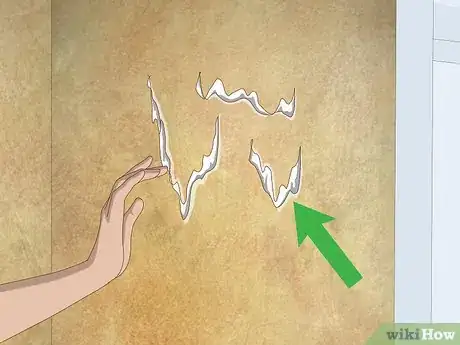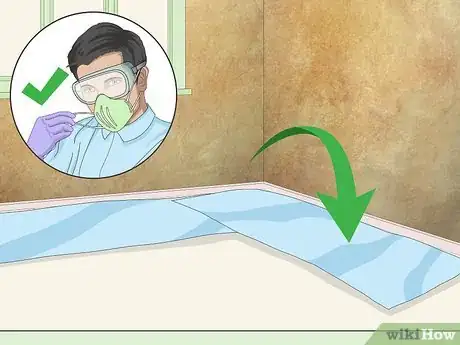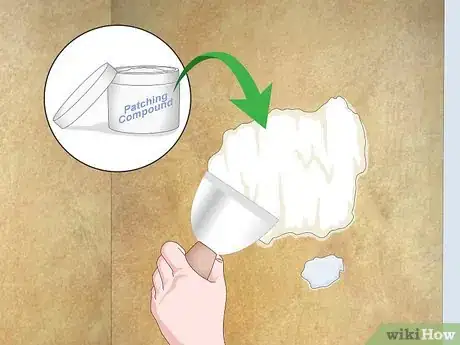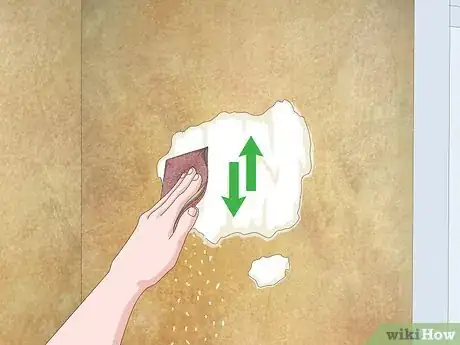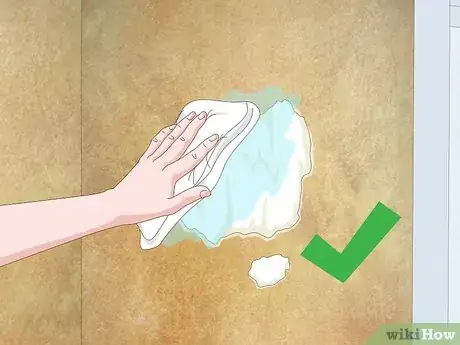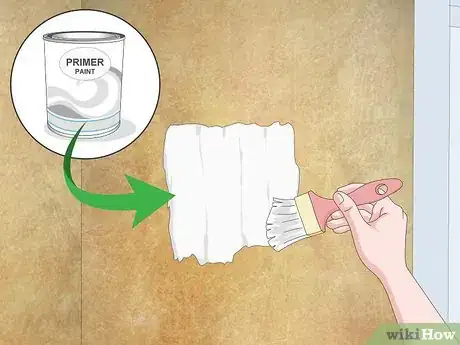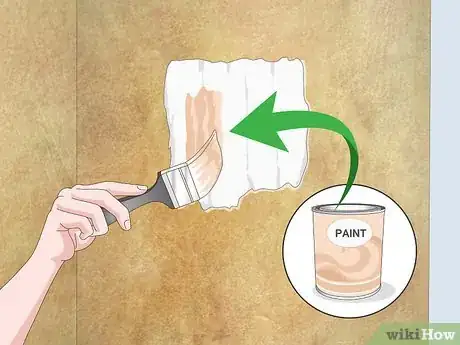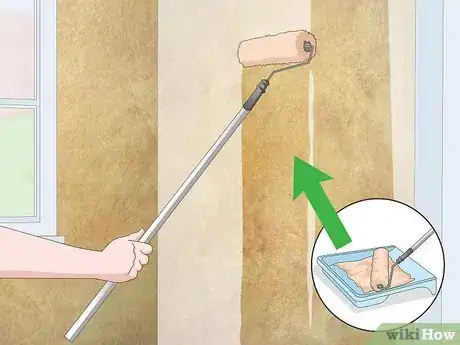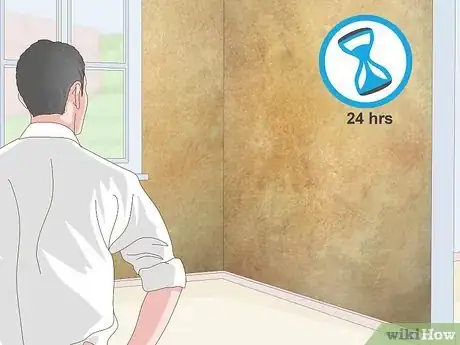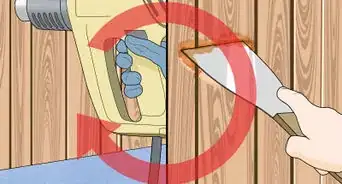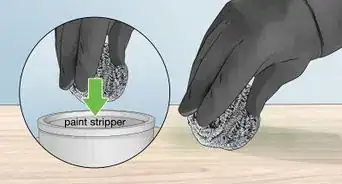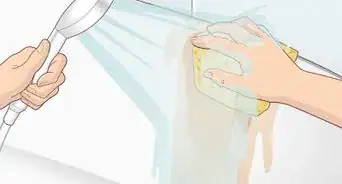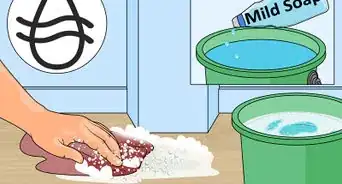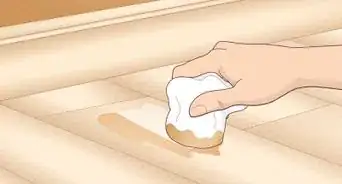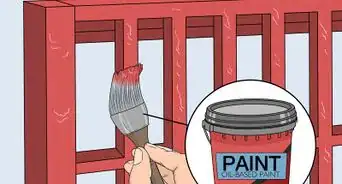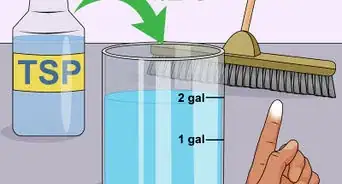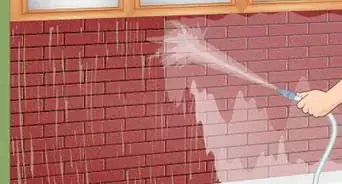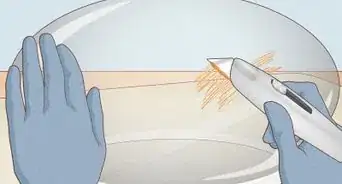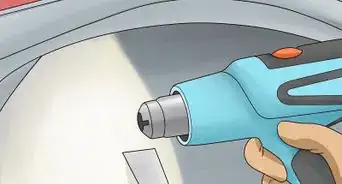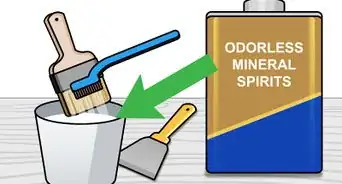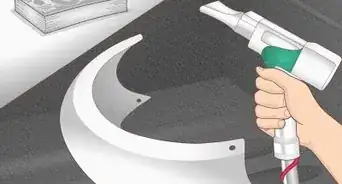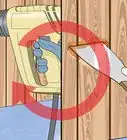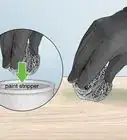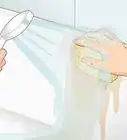This article was co-authored by Patrick Coye and by wikiHow staff writer, Jessica Gibson. Patrick Coye is the owner and operator of Patrick’s Painting & Home Improvement in Alexandria, Virginia. With over 15 years of experience in residential construction, Patrick specializes in painting, wallpaper removal/installation, drywall, staining decks and fences, and kitchen cabinetry painting. To date, Patrick and his team have painted over 2,000 houses and stained over 800 decks. Patrick's Company won a "Top Job" award from the American Painting contractor magazine in 2020.
This article has been viewed 126,091 times.
If you've been meaning to do something about the peeling paint on your walls, grab a few supplies and get started! Lay down a cloth or tarp to catch any dried paint before you begin. Then, use a putty knife or flat blade to scrape away the peeling paint. Repair the surface by filling holes or cracks, cleaning the surface, and priming it. Once the area is dry, you can repaint it with a thin coat of fresh paint.
Steps
Locating and Removing Peeling Paint
-
1Remove excess moisture near the painted area. Since moisture can get underneath the paint and cause peeling, look for leaking or temperature fluctuations that cause sweating. For example, if you have peeling paint in the bathroom, the extreme temperatures and humidity can cause peeling. Consider using a dehumidifier in that room.[1]
- If the exterior paint is peeling, check around your gutters or roof to see if they're leaking onto the painted walls. If the walls near the kitchen or bathroom are peeling, you may need to see if the pipes are leaking.
-
2Identify areas of peeling paint. Because several things can cause peeling paint, your peeling walls may show damage differently. Look for peeling, cracking, or flaking areas of paint. You might even see areas that have extreme cracking that looks like alligator skin.[2]
- These signs of damage can be caused by moisture getting under the paint or by painting on a surface that wasn't cleaned or primed well. Using cheap paint or painting second coats before letting the first coat dry can also cause damage.
Advertisement -
3Protect your work space and yourself. Once you've located the peeled paint, lay down old towels, a tarp, or a sheet of plastic underneath the space. If the peeled paint is on the main part of a wall, apply painter's tape to the trim. To protect yourself from ingesting old paint, put on a safety mask, glasses, and gloves.[3]
- The old towel or tarp will catch the old paint and debris that you scrape off of the wall.
-
4Scrape off all of the peeling paint. Choose a flat blade to scrape against the wall with the peeling paint. The old paint should come right off and fall onto your towel, plastic sheet, or tarp. You can use a stiff-blade putty knife, wire brush, or paint scraper. Scrape until you don't see any peeling paint on the wall.[4]
- Try scraping most of the paint away with something like a 5-in-1 tool, then sand away any remaining paint with sandpaper.[5]
- Once you get to an area where the paint doesn't come off easily, you can stop scraping.[6]
- Since removing peeling paint can expose toxic lead dust, pregnant women and children should avoid the area.
Repairing and Repainting the Surface
-
1Fill any cracks or holes. If you're repairing an interior surface, dip a putty knife into quick-setting patching compound. For an exterior surface, dip it into exterior spackling compound paste. Spread a thin layer over the damaged surface so any cracks or holes are filled. Check the manufacturer's instructions to see how long the material needs to dry.[7]
- If you apply the compound too thickly, the wall will feel bumpy.
-
2Sand the space. After you make the repair, take a piece of fine-grit sandpaper and rub it over the space that you filled with compound. To repair a larger area, you can use a disc sander with a 60 to 120-grit disc. Sand the area until the surface feels smooth and blends in with the surrounding surface.[8]
- If you don't want to buy a disc sander, you might be able to rent one from a hardware store.
- Don't worry about getting the area too smooth—you want there to be a little grit for the primer to adhere to.[9]
-
3Wipe the area clean with a cloth. Dip a sponge or cloth into water and wring it out so it's just damp. Wipe the space that you sanded to remove any dirt, dust, or old paint. Take a dry cloth and wipe it again so there's no moisture on the surface. The surface should be completely dry before you continue.[10]
- If you've repaired a large exterior surface, you may need to hose it down with water. You'll need to wait 2 to 3 days before preparing the surface for painting.
-
4Apply a coat of primer. Dip a brush or roller into a high-quality paint primer. Spread a thin, even layer of the primer over your repaired surface and let it dry completely. This can take several hours or up to a day depending on the brand of primer. If you're applying primer to an exterior space, you can use a spray applicator to cover it.[11]
- For a bathroom or kitchen, use an oil-based primer that can block stains. This type of primer will also protect humid surfaces from mildew.
-
5Touch up small surfaces with new paint. If you're just repainting a small repaired area, you can get out the can of paint that you originally used to paint the space or buy a sample-sized can of paint. Dip a bristle or sponge brush into the paint. Spread it directly over the primed surface and brush away towards the edges.[12]
-
6Repaint large surfaces. If you repaired lots of peeling patches on a wall, you may need to repaint the whole wall. Pour your paint into a paint tray and coat a paint roller in it. Apply the paint in a light, even layer. Let it dry before you apply another coat of paint.[13]
-
7Dry the space. For interior walls, let the repaired areas dry for at least a day before you touch them or hang things up on them. If you repaired peeling paint in a bathroom, wait a full day before you take a shower or bath because this can introduce moisture.[14]
- Since you can't control how humid your outdoor surfaces get, just try to do your painting repairs when there are a few dry days forecasted.
Expert Q&A
Did you know you can get expert answers for this article?
Unlock expert answers by supporting wikiHow
-
QuestionCan I paint over peeling paint?
 Patrick CoyePatrick Coye is the owner and operator of Patrick’s Painting & Home Improvement in Alexandria, Virginia. With over 15 years of experience in residential construction, Patrick specializes in painting, wallpaper removal/installation, drywall, staining decks and fences, and kitchen cabinetry painting. To date, Patrick and his team have painted over 2,000 houses and stained over 800 decks. Patrick's Company won a "Top Job" award from the American Painting contractor magazine in 2020.
Patrick CoyePatrick Coye is the owner and operator of Patrick’s Painting & Home Improvement in Alexandria, Virginia. With over 15 years of experience in residential construction, Patrick specializes in painting, wallpaper removal/installation, drywall, staining decks and fences, and kitchen cabinetry painting. To date, Patrick and his team have painted over 2,000 houses and stained over 800 decks. Patrick's Company won a "Top Job" award from the American Painting contractor magazine in 2020.
Painting Specialist
-
QuestionWhy is the paint peeling if there is no moisture in the room?
 Mya LCommunity AnswerIt's probably due to an improperly prepared surface. The moisture might be coming from under the wall. Even if you think there is no moisture in the room, there probably is, so do a thorough check. You may need to get behind or under it to really find the source.
Mya LCommunity AnswerIt's probably due to an improperly prepared surface. The moisture might be coming from under the wall. Even if you think there is no moisture in the room, there probably is, so do a thorough check. You may need to get behind or under it to really find the source.
Warnings
- Always use caution when getting on a ladder to inspect or make paint repairs, regardless of whether you're fixing the paint on a wall or ceiling. Have someone hold the base of the ladder steady while you're on it.⧼thumbs_response⧽
Things You'll Need
Locating and Removing Peeling Paint
- Safety mask
- Protective glasses
- Gloves
- Painter's tape
- Old towel, tarp, or sheet of plastic
- Stiff-blade putty knife, wire brush, or paint scraper.
- Ladder, optional
Repairing and Repainting the Surface
- Putty knife
- Safety mask
- Protective glasses
- Gloves
- Quick-setting patching compound or exterior spackling compound paste
- Fine grit sanding sponge or disc sander with a 60 to 120-grit disc
- Sponge or cloth
- High-quality primer
- Brush, roller, or spray applicator
- Paint
- Bristle or sponge brush
- Paint tray
References
- ↑ https://projects.truevalue.com/paint/exterior/prep_cleanup_and_safety/how_to_fix_peeling_paint.aspx
- ↑ https://www.bobvila.com/articles/what-to-do-about-peeling-paint/#.Wej7q9enHIU
- ↑ http://www.bhg.com/decorating/paint/how-tos/how-to-fix-peeling-paint/
- ↑ https://www.bobvila.com/articles/what-to-do-about-peeling-paint/#.Wej7q9enHIU
- ↑ Patrick Coye. Painting Specialist. Expert Interview. 22 July 2020.
- ↑ Patrick Coye. Painting Specialist. Expert Interview. 22 July 2020.
- ↑ https://www.bobvila.com/articles/what-to-do-about-peeling-paint/#.WekwMtenHIV
- ↑ https://projects.truevalue.com/paint/exterior/prep_cleanup_and_safety/how_to_fix_peeling_paint.aspx
- ↑ Patrick Coye. Painting Specialist. Expert Interview. 22 July 2020.
- ↑ http://www.bhg.com/decorating/paint/how-tos/how-to-fix-peeling-paint/
- ↑ https://projects.truevalue.com/paint/exterior/prep_cleanup_and_safety/how_to_fix_peeling_paint.aspx
- ↑ https://projects.truevalue.com/paint/exterior/prep_cleanup_and_safety/how_to_fix_peeling_paint.aspx
- ↑ https://projects.truevalue.com/paint/exterior/prep_cleanup_and_safety/how_to_fix_peeling_paint.aspx
- ↑ https://www.bobvila.com/articles/what-to-do-about-peeling-paint/#.WelwXmhSzIW
About This Article
To repair peeling paint, start by scraping the peeling paint off of the surface with a flat blade. Next, fill any cracks or holes in the surface with quick-setting patching compound, let the compound dry, and sand the area. Then, apply a thin, even layer of primer over the surface and let it dry completely. Finally, repaint the repaired surface with two coats of new paint and let it dry for at least 24 hours before touching or using the space. For tips on figuring out what's causing the peeling, read on!

